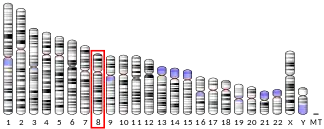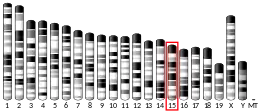Zinc transporter 8 (ZNT8) is a protein that in humans is encoded by the SLC30A8 gene.[5] ZNT8 is a zinc transporter related to insulin secretion in humans. In particular, ZNT8 is critical for the accumulation of zinc into beta cell secretory granules and the maintenance of stored insulin as tightly packaged hexamers. Certain alleles of the SLC30A8 gene may increase the risk for developing type 2 diabetes, but a loss-of-function mutation appears to greatly reduce the risk of diabetes.[6]
Clinical significance
Association with type 2 diabetes (T2D)
Twelve rare variants in SLC30A8 have been identified through the sequencing or genotyping of approximately 150,000 individuals from 5 different ancestry groups. SLC30A8 contains a common variant (p.Trp325Arg), which is associated with T2D risk and levels of glucose and proinsulin.[7][8][9] Individuals carrying protein-truncating variants collectively had 65% reduced risk of T2D. Additionally, non-diabetic individuals from Iceland harboring a frameshift variant p. Lys34Serfs*50 demonstrated reduced glucose levels.[6] Earlier functional studies of SLC30A8 suggested that reduced zinc transport increased T2D risk.[10][11] Conversely, loss-of-function mutations in humans indicate that SLC30A8 haploinsufficiency protects against T2D. Therefore, ZnT8 inhibition can serve as a therapeutic strategy in preventing T2D.[6]
See also
References
- 1 2 3 GRCh38: Ensembl release 89: ENSG00000164756 - Ensembl, May 2017
- 1 2 3 GRCm38: Ensembl release 89: ENSMUSG00000022315 - Ensembl, May 2017
- ↑ "Human PubMed Reference:". National Center for Biotechnology Information, U.S. National Library of Medicine.
- ↑ "Mouse PubMed Reference:". National Center for Biotechnology Information, U.S. National Library of Medicine.
- ↑ "Entrez Gene: SLC30A8 solute carrier family 30 (zinc transporter), member 8".
- 1 2 3 Flannick, Jason; et al. (2014). "Loss-of-function mutations in SLC30A8 protect against type 2 diabetes". Nature Genetics. 46 (4): 357–363. doi:10.1038/ng.2915. PMC 4051628. PMID 24584071.
- ↑ Dupis, J.; et al. (Feb 2010). "New genetic loci implicated in fasting glucose homeostasis and their impact on type 2 diabetes risk". Nature Genetics. 42 (2): 105–16. doi:10.1038/ng.520. PMC 3018764. PMID 20081858.
- ↑ Strawbridge, R.J.; et al. (October 2011). "Genome-wide association identifies nine common variants associated with fasting proinsulin levels and provides new insights into the pathophysiology of type 2 diabetes". Diabetes. 60 (10): 2624–34. doi:10.2337/db11-0415. PMC 3178302. PMID 21873549.
- ↑ Morris, A.P.; et al. (Sep 2012). "Large-scale association analysis provides insights into the genetic architecture and pathophysiology of type 2 diabetes". Nature Genetics. 44 (9): 981–90. doi:10.1038/ng.2383. PMC 3442244. PMID 22885922.
- ↑ Nicolson, T.J.; et al. (Sep 2009). "Insulin storage and glucose homeostasis in mice null for the granule zinc transporter ZnT8 and studies of the type 2 diabetes–associated variants". Diabetes. 58 (9): 2070–83. doi:10.2337/db09-0551. PMC 2731533. PMID 19542200.
- ↑ Rutter, G.A.; et al. (2010). "Think zinc: new roles for zinc in the control of insulin secretion". Islets. 2 (1): 49–50. doi:10.4161/isl.2.1.10259. PMID 21099294.
Further reading
- Chimienti F, Favier A, Seve M (2006). "ZnT-8, a pancreatic beta-cell-specific zinc transporter". Biometals. 18 (4): 313–7. doi:10.1007/s10534-005-3687-9. PMID 16158222. S2CID 25680038.
- Hartley JL, Temple GF, Brasch MA (2001). "DNA cloning using in vitro site-specific recombination". Genome Res. 10 (11): 1788–95. doi:10.1101/gr.143000. PMC 310948. PMID 11076863.
- Wiemann S, Weil B, Wellenreuther R, et al. (2001). "Toward a catalog of human genes and proteins: sequencing and analysis of 500 novel complete protein coding human cDNAs". Genome Res. 11 (3): 422–35. doi:10.1101/gr.GR1547R. PMC 311072. PMID 11230166.
- Strausberg RL, Feingold EA, Grouse LH, et al. (2003). "Generation and initial analysis of more than 15,000 full-length human and mouse cDNA sequences". Proc. Natl. Acad. Sci. U.S.A. 99 (26): 16899–903. Bibcode:2002PNAS...9916899M. doi:10.1073/pnas.242603899. PMC 139241. PMID 12477932.
- Seve M, Chimienti F, Devergnas S, Favier A (2004). "In silico identification and expression of SLC30 family genes: an expressed sequence tag data mining strategy for the characterization of zinc transporters' tissue expression". BMC Genomics. 5 (1): 32. doi:10.1186/1471-2164-5-32. PMC 428573. PMID 15154973.
- Chimienti F, Devergnas S, Favier A, Seve M (2004). "Identification and cloning of a beta-cell-specific zinc transporter, ZnT-8, localized into insulin secretory granules". Diabetes. 53 (9): 2330–7. doi:10.2337/diabetes.53.9.2330. PMID 15331542.
- Gerhard DS, Wagner L, Feingold EA, et al. (2004). "The status, quality, and expansion of the NIH full-length cDNA project: the Mammalian Gene Collection (MGC)". Genome Res. 14 (10B): 2121–7. doi:10.1101/gr.2596504. PMC 528928. PMID 15489334.
- Wiemann S, Arlt D, Huber W, et al. (2004). "From ORFeome to biology: a functional genomics pipeline". Genome Res. 14 (10B): 2136–44. doi:10.1101/gr.2576704. PMC 528930. PMID 15489336.
- Mehrle A, Rosenfelder H, Schupp I, et al. (2006). "The LIFEdb database in 2006". Nucleic Acids Res. 34 (Database issue): D415–8. doi:10.1093/nar/gkj139. PMC 1347501. PMID 16381901.
- Sladek R, Rocheleau G, Rung J, et al. (2007). "A genome-wide association study identifies novel risk loci for type 2 diabetes". Nature. 445 (7130): 881–5. Bibcode:2007Natur.445..881S. doi:10.1038/nature05616. PMID 17293876. S2CID 4302932.
- Wenzlau JM, Juhl K, Yu L, et al. (2007). "The cation efflux transporter ZnT8 (Slc30A8) is a major autoantigen in human type 1 diabetes". Proc. Natl. Acad. Sci. U.S.A. 104 (43): 17040–5. Bibcode:2007PNAS..10417040W. doi:10.1073/pnas.0705894104. PMC 2040407. PMID 17942684.
External links
- Type 2 diabetes genes mapped out, BBC News article




